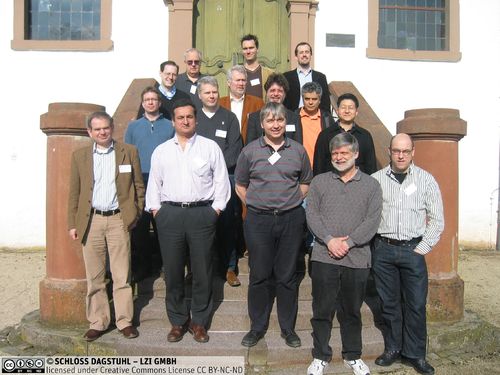Dagstuhl Seminar 08142
Combining the Advantages of Product Lines and Open Source
( Apr 02 – Apr 05, 2008 )
Permalink
Organizers
- Jesus Bermejo (Telvent S.A. - Sevilla, ES)
- Björn Lundell (University of Skovde, SE)
- Frank van der Linden (Philips Medical Systems - Best, NL)
Contact
Press Reviews
-
Kann das denn funktionieren? Open Source Software auch in der Industrie?
Computerclub Zwei, Folge 109, 19.5.2008 (in German)
From April 2 to 5, the Dagstuhl Seminar 08142 "Combining the Advantages of Product Lines and Open Source" was held in the International Conference and Research Center (IBFI), Schloss Dagstuhl. During the seminar, several participants presented their current research, and ongoing work and open problems were discussed. Abstracts of the presentations given during the seminar as well as abstracts of seminar results and ideas are put together in this paper. The first section describes the seminar topics and goals in general.
Practitioners and researchers have already identified the potential cross-fertilisation benefits of software product lines and open source software development.
Product line development is being established as an important way of producing software in companies. This ensured an efficient way to obtain a variety of products. It is also an important contemporary research issue, as indicated by the recent special issue of Communications of the ACM, December 2006.
Using open source software appears to be a profitable way to obtain good software. This is a result of several of its properties, ranging from effective feedback to the openness of the source. At a first glance open source and product line practices are conflicting.
This workshop aims to find ways to overcome these conflicting practices and how to profit from both approaches. Product line engineering can improve in agility and fast feedback improving the quality of the result. Open source software development can profit for variability management techniques, developed in product line engineering to improve the efficiency to deal with a diversity of configurations.
In-depth description of the topic
Product line engineering sets up several processes to enable efficient management of reuse and variability. As a consequence, a large initial investment is done, and a lot of rules are put down to enable ease of traceability and the insurance that different sets of requirements lead to a fast production of diverse products. In principle product line engineering is a top-down process.
This process is often executed in large developments within companies involving distributed development. This distribution factor makes product-line engineering complex. How to ensure that the rules are followed in a distributed organisation.
Development of open source software typically starts bottom-up. As such, it has in many cases shown to be an effective way to get a large group of people working together on the same topic, building high quality software. Often, the people did not met before, but they share the interest for the code they are dealing with.
Open source development is intrinsically distributed, and its practices may a lot to offer to traditional distributed development. In fact, the open source development model has been adopted by companies as "inner source development", as a way to improve their distributed development.
Product line practices involving the planning and mangemernt of variability and reuse may be useful for open source communities and companies adopting open source practices. Many tools available within the open source world deal with versions and configurations. However they still do not perform effectively and friendly at the level of a user wanting to configuring the software.
The seminar was visited by 15 participants from the product line world and from open source communities. Most of them presented a position paper giving rise to a lot of discussion.
- Jesus Bermejo (Telvent S.A. - Sevilla, ES)
- Gary J. Chastek (Carnegie Mellon University - Pittsburgh, US)
- Hans Petter Dahle (ICT Norway, NO)
- Daniel M. German (University of Victoria, CA) [dblp]
- Øystein Haugen (University of Oslo, NO) [dblp]
- Stefan Koch (Wirtschaftsuniversität Wien, AT)
- Joseba Laka (Europ. SW Institute - Bilbao, ES)
- Jaejoon Lee (Lancaster University, GB)
- Björn Lundell (University of Skovde, SE)
- Pentti Marttiin (Nokia Siemens Networks - Helsinki, FI)
- Anders Mattsson (Combitech AB - Jönköping, SE)
- John D. McGregor (Clemson University, US) [dblp]
- Patrick Oor (ICT NoviQ, NL)
- Frank van der Linden (Philips Medical Systems - Best, NL) [dblp]
- Jilles Van Gurp (NOKIA Research Center - Helsinki, FI)
Classification
- sw-engineering
Keywords
- product lines
- product families
- open source development
- distributed development
- agility
- variability management


